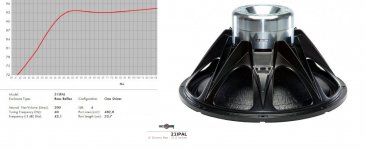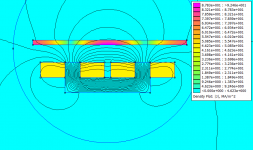Hi All:
This is a hypothetical question.
Is it not possible, using modern solid state tech, to sample the (unused) 2nd coil induced voltage in a driver, compare it to the signal going into the first and dynamically correct/ EQ the drive signal so that distortions are minimized?
With this ability, odd speaker resonances or over drive due to loss of air resistance or leaks in the box design can be electronically improved upon, on the fly?
Ancel
This is a hypothetical question.
Is it not possible, using modern solid state tech, to sample the (unused) 2nd coil induced voltage in a driver, compare it to the signal going into the first and dynamically correct/ EQ the drive signal so that distortions are minimized?
With this ability, odd speaker resonances or over drive due to loss of air resistance or leaks in the box design can be electronically improved upon, on the fly?
Ancel
The IPAL system uses a separate sensor for the feedback loop, the woofer uses a single 1 ohm voice coil.
B&C Speakers - 21IPAL
Has this OEM 6"COIL/1 ohm Ipal anything to do with it?
21IPAL 21" LF Drivers Neo Woofer, 5000W - B&C Speakers - Technologies For Worship Magazine - Audio Video Product Directory
http://catalogs.infocommiq.com/avcat/images/documents/dataSheet/21IPAL.pdf
Has this OEM 6"COIL/1 ohm Ipal anything to do with it?
21IPAL 21" LF Drivers Neo Woofer, 5000W - B&C Speakers - Technologies For Worship Magazine - Audio Video Product Directory
http://catalogs.infocommiq.com/avcat/images/documents/dataSheet/21IPAL.pdf
Attachments
This reminds me of a story I once heard (probably on tv or radio) about an acoustic guitarist who discovered on his own how to clamp down the strings on the fretboard so he could change key. He spent days on his idea, and was introduced to the capo by friends 🙂
How about this story....great tech...high price....avg joe can't buy it. Must be a way to make it cheaper?
Yes, there are. Using one of the coils on a standard dual voice coil woofer as only a sensor would be very inefficient, which is why separate sensors are usually employed for the loop. Some approaches use sensors mounted on the cone, others like the IPAL and Meyers have sensors externally mounted.How about this story....great tech...high price....avg joe can't buy it. Must be a way to make it cheaper?
High quality subwoofers have quite low distortion to start with, the technology makes the most difference when using less linear (cheap) drivers.
Here are a couple threads outlining various DIY approaches:
http://www.diyaudio.com/forums/digital-source/63397-servo-feedback-subwoofer.html
http://www.diyaudio.com/forums/subwoofers/239941-analog-servo-sub.html
After reviewing both, and the IPAL and Meyers approaches, I still prefer spending my money on additional good drivers run within their linear range rather than spending more money trying to thrash a driver within a millimeter of it's life to extract similar performance.
Art
I'm aware that he such technology commercially exists. However, I am surprised that (as far as I know) that Bose never did anything similar. Other than mediocre-to-good audio products at good-to-high prices (That should appease all you critics out there!), the evil Empire on the Mountain also at least experimented with active shock absorbers for vehicles. Seems this would tie in directly with smoothing an unruly subwoofer.
@ Inductor
Hi, that Audio Visual Equipment, AV Service Providers Directory and Resource Center - AV-iQ link you gave is a nice resource of info 🙂
Re the 21IPAL
They claim it's 99dB ! Well if anyone is interested in a so called woofer @ 1.5kHz, then it's true. Otherwise it's a LOT less then that. Even they show it 93dB @ 41Hz in a box. I'm really surprised @ B&C, as i expect better from them not to be misleading, or in this case an outright lie 😡
Hi, that Audio Visual Equipment, AV Service Providers Directory and Resource Center - AV-iQ link you gave is a nice resource of info 🙂
Re the 21IPAL
They claim it's 99dB ! Well if anyone is interested in a so called woofer @ 1.5kHz, then it's true. Otherwise it's a LOT less then that. Even they show it 93dB @ 41Hz in a box. I'm really surprised @ B&C, as i expect better from them not to be misleading, or in this case an outright lie 😡
It's a peak rating (Peak ratings - by Bill Fitzmaurice) BillFitzmaurice.info - View topic - JBL 804 vs TangBand 740P
I don't think it's a Peak rating.
They claim - Sensitivity (1W/1m) 99.0 dB,
So maybe it's due to the driver being a 1 Ohm device. The impedance @ 1.5kHz = 5 Ohms
They claim - Sensitivity (1W/1m) 99.0 dB,
So maybe it's due to the driver being a 1 Ohm device. The impedance @ 1.5kHz = 5 Ohms
B&C Speakers - 21IPAL
http://catalogs.infocommiq.com/avcat/images/documents/dataSheet/21IPAL.pdf
I have to laugh at companies/people that don't even know how to make a logarithmic scatter plot in excel when they submit graphs to "engineering types"...
Is that the plot of the output of the enclosure in the bottom?how to make a logarithmic scatter plot in excel when they submit graphs to "engineering types"...
Isn't that a simulation. The scales can be of your choice in the software presentation?! (I guess, if not, can you address that problem). 😕
M-Force by Powersoft - YouTube
Moving Magnet vs. Field Coil vs. Servo Control vs. DVC
Amazing technology. Maybe only for a concert type installation (for the OP) why should you choose one?! 😀
Moving Magnet vs. Field Coil vs. Servo Control vs. DVC
Amazing technology. Maybe only for a concert type installation (for the OP) why should you choose one?! 😀
Attachments
Last edited:
IPAL
IPAL (Integrated Powered Adaptive Loudspeaker)
The IPAL principle maximises the efficiency of electro-acoustic
conversion of a transducer i.e. the way in which the mains
input power is converted into actual acoustic output.
Traditional transducer design is compromised by the need to
present an amplifier with a load impedance that is as
resistive as possible – which implies a loss of efficiency of
the transducer and also sets a limit on the current in the
voice coil because of thermal dissipation. A transducer that
would minimise the voice coil resistance, maximise the Bl
"force factor", or that would present a more reactive load,
would enable a significant increase in the conversion
efficiency.
In the practical embodiment of the IPAL principle in the ASX,
DSP controlled, active feedback topology "emulates" an ideal
virtual "target" transducer to maximise efficiency and
maintain linearity at maximum excursion. Distortion is
reduced by up to 20dB and power compression virtually
eliminated. The IPAL system in the ASX comprises a
dedicated Class D amplifier module, a DSP system,
a 21" (530mm) transducer unlike any other and a differential
pressure sensor.
the drive unit
A neodymium motor system of immense proportions,
coupled with a voice coil impedance of less than one ohm
enables the drive unit to generate an unprecedented force
upon the air load presented by the enclosure. This ability
dominates the rest of the driver's electro-acoustic
parameters thus creating the "virtual transducer".
By adjusting the processing in the control loop, fixed
parameters such as moving mass, resonant frequency and
even cone area can be "virtually" adjusted and optimised.
To handle the unprecedented forces and resultant air
pressures requires an extremely strong cone material. Made
from a mix of cellulose and carbon fibres, the cone has
excellent strength when in tension and compression – unlike
woven aramid fibre cones, whose compressive strength is
much lower than their tensile capabilities.
Martin Audio ASX
DPC Differential Pressure Control
INNOVATIVE AND PATENTED TECHNOLOGY FOR A NEW ELECTROACUSTIC DEVELOPMENT ENVIRONMENT
DPC - Differential Pressure Control™ is the core technology of IPAL, Integrated Powered Adaptive Loudspeaker, an innovative Powersoft patented technology that will open a new era in the electroacoustic design by providing acoustic designers with tools able to overcome the physical limitations of the currently available components.
This technology integrate, in a single development environment, electroacustic advanced functionalities possible only with an extremely powerful DSP and with "zero latency" (10 us), able to react in real time to the changes of the "user defined" performance. These performance can be set as desired SPL or equivalent parameters of the transducer as a sort of "virtual transducer" modeling.
DPC Differential Pressure Control - Powersoft Audio

IPAL (Integrated Powered Adaptive Loudspeaker)
The IPAL principle maximises the efficiency of electro-acoustic
conversion of a transducer i.e. the way in which the mains
input power is converted into actual acoustic output.
Traditional transducer design is compromised by the need to
present an amplifier with a load impedance that is as
resistive as possible – which implies a loss of efficiency of
the transducer and also sets a limit on the current in the
voice coil because of thermal dissipation. A transducer that
would minimise the voice coil resistance, maximise the Bl
"force factor", or that would present a more reactive load,
would enable a significant increase in the conversion
efficiency.
In the practical embodiment of the IPAL principle in the ASX,
DSP controlled, active feedback topology "emulates" an ideal
virtual "target" transducer to maximise efficiency and
maintain linearity at maximum excursion. Distortion is
reduced by up to 20dB and power compression virtually
eliminated. The IPAL system in the ASX comprises a
dedicated Class D amplifier module, a DSP system,
a 21" (530mm) transducer unlike any other and a differential
pressure sensor.
the drive unit
A neodymium motor system of immense proportions,
coupled with a voice coil impedance of less than one ohm
enables the drive unit to generate an unprecedented force
upon the air load presented by the enclosure. This ability
dominates the rest of the driver's electro-acoustic
parameters thus creating the "virtual transducer".
By adjusting the processing in the control loop, fixed
parameters such as moving mass, resonant frequency and
even cone area can be "virtually" adjusted and optimised.
To handle the unprecedented forces and resultant air
pressures requires an extremely strong cone material. Made
from a mix of cellulose and carbon fibres, the cone has
excellent strength when in tension and compression – unlike
woven aramid fibre cones, whose compressive strength is
much lower than their tensile capabilities.
Martin Audio ASX
DPC Differential Pressure Control
INNOVATIVE AND PATENTED TECHNOLOGY FOR A NEW ELECTROACUSTIC DEVELOPMENT ENVIRONMENT
DPC - Differential Pressure Control™ is the core technology of IPAL, Integrated Powered Adaptive Loudspeaker, an innovative Powersoft patented technology that will open a new era in the electroacoustic design by providing acoustic designers with tools able to overcome the physical limitations of the currently available components.
This technology integrate, in a single development environment, electroacustic advanced functionalities possible only with an extremely powerful DSP and with "zero latency" (10 us), able to react in real time to the changes of the "user defined" performance. These performance can be set as desired SPL or equivalent parameters of the transducer as a sort of "virtual transducer" modeling.
DPC Differential Pressure Control - Powersoft Audio

- Status
- Not open for further replies.
- Home
- Loudspeakers
- Subwoofers
- New use for dual coil in a driver

